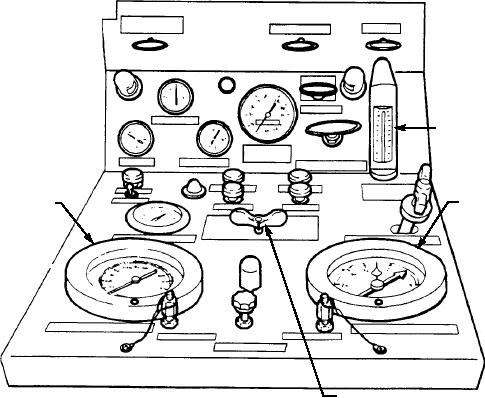
FLOWMETER
HIGH
PRESSURE
COMPOUND
GAUGE
GAUGE
SELECTOR
ASf08039
VALVE
Figure 8-39.--A/M27T-5 control panel, controls, instruments, and gauges.
Pressure Gauge Snubbers
the control panel of the A/M27T-5 hydraulic test stand.
Note that the panel shows a variety of gauges. The large
A pressure gauge snubber (fig. 8-40) is a hydraulic
gauge on the left of the panel (1) is an example of a 0 to
component that is located upstream of a pressure
6,000 psi hydraulic pressure gauge.
gauge. Its function is to dampen out system pressure
surges that could cause damage to a gauge. Without a
Compound Gauges
snubber, pressure oscillations and sudden pressure
Compound gauges in hydraulic systems are used
changes could affect the delicate internal mechanism
to indicate pressure or suction in the system. They
of a gauge. Also, by removing oscillations, it makes a
normally indicate vacuum from 0 to 30 inches of
gauge easier to read.
mercury (in.Hg) and pressure from 0 to 300 psi. The
The basic components of a snubber are the
compound gauge shown in figure 8-39 (2) is used in
housing, fitting assembly (with a fixed orifice), and the
conjunction with the directional valves (3) to indicate
pin and plunger assembly. The snubbing action is
back pressure or suction in the return line, the inlet to
obtained by metering fluid through the snubber. The
the low-pressure pump, or the inlet to the high-pressure
fitting assembly orifice restricts the amount of fluid
pump.
that flows to the gauge, thereby snubbing the force of a
Defective gauges are removed and replaced with
pressure surge. The pin is pushed and pulled through
good ones. Defective gauges are then turned in to the
the orifice of the fitting assembly by the plunger,
AIMD calibration lab for repair or to be condemned
keeping it clear and at uniform size.
and deleted from the calibration inventory.
Calibration of Gauges
Flowmeters
If a pressure gauge is not functioning properly, it
Flowmeters are used in hydraulic power supplies
could lead to damage to the system it monitors. It could
and component test benches to indicate the rate of flow
also be a safety hazard to personnel. For this reason,
of fluids, usually in gallons per minute (fig. 8-39). One
NAVAIRSYSCOM requires that pressure gauges used
use of a flowmeter, for example, is in testing the output
to service tires, shock struts, and hydraulic
of pumps. The most common type of flowmeter used is
accumulators be calibrated every 30 days. On
the rotameter, which is described in Fluid Power,
servicing equipment with multiple-gauge
NAVEDTRA 14105.
installations, only the gauge or gauges that monitor the
8-32

